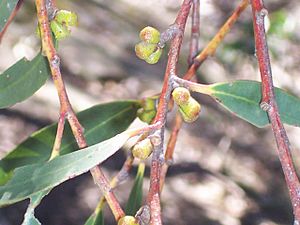Pigeon House ash facts for kids
Quick facts for kids Pigeon House ash |
|
|---|---|
 |
|
| Eucalyptus triflora at Pigeon House Mountain | |
| Scientific classification | |
| Genus: |
Eucalyptus
|
| Species: |
triflora
|
Eucalyptus triflora, often called Pigeon House ash or three-flowered ash, is a special kind of small tree. It is found only in a small area of New South Wales, Australia. This tree has smooth bark, long, thin leaves, and its flower buds usually grow in groups of three. It produces white flowers and fruit shaped like an urn.
Contents
What Does Pigeon House Ash Look Like?
The Pigeon House ash is a tree that usually grows to be about 12 to 15 meters (around 40 to 50 feet) tall. It has a special woody swelling at its base called a lignotuber. This helps the tree regrow if it gets damaged, for example, by fire.
Its Bark and Leaves
The bark of this tree is smooth and can be white or cream-colored. It often has wiggly lines on it made by insects. Older trees might have rough, dark grey bark near the bottom.
- Young plants and new shoots (called coppice regrowth) have shiny green leaves. These leaves are paler on the underside and are shaped like a spear or are slightly curved. They are about 4 to 11 centimeters (1.5 to 4.3 inches) long and 1.5 to 4 centimeters (0.6 to 1.6 inches) wide.
- Adult leaves grow in an alternating pattern along the stem. They are shiny green on both sides and are also spear-shaped or curved. These leaves are longer, about 7 to 16 centimeters (2.8 to 6.3 inches) long and 0.8 to 3 centimeters (0.3 to 1.2 inches) wide. They narrow down to a stalk called a petiole, which is about 0.7 to 1.8 centimeters (0.3 to 0.7 inches) long.
Flowers and Fruit
The flower buds grow in the leaf axils (the angle between a leaf and the stem). They usually appear in groups of three on a short stalk called a peduncle, which is about 3 to 7 millimeters (0.1 to 0.3 inches) long. The individual buds do not have their own stalks; they are "sessile" (attached directly).
- Mature buds are oblong, about 7 to 8 millimeters (0.3 inches) long and 4 to 5 millimeters (0.16 to 0.2 inches) wide. They have a rounded or cone-shaped cap called an operculum.
- Pigeon House ash trees bloom from December to March, and their flowers are white.
- The fruit is a woody, urn-shaped or barrel-shaped capsule. It is about 6 to 11 millimeters (0.24 to 0.43 inches) long and 7 to 12 millimeters (0.28 to 0.47 inches) wide. The parts that open to release the seeds (called valves) are at or below the rim of the fruit.
How Did Pigeon House Ash Get Its Name?
The Pigeon House ash was first officially described in 1907 by a botanist named Joseph Maiden. He wrote about it in his book The Forest Flora of New South Wales. The specimens (samples) he used were collected from the top of Pigeon House Mountain by Richard Hind Cambage.
- Maiden first named it Eucalyptus virgata var. triflora.
- Later, in 1934, another botanist, William Blakely, decided it was unique enough to be its own species. He then gave it the name Eucalyptus triflora.
- The second part of its scientific name, triflora, comes from two Latin words: "tri," meaning "three," and "flora," meaning "flowered." This refers to how its flower buds usually grow in groups of three.
Where Does Pigeon House Ash Grow?
Eucalyptus triflora often grows among sandstone boulders in higher areas. You might also find it in heathlands, open forests, or woodlands.
It grows in a few separate areas (this is called a disjunct distribution) in New South Wales. These places include areas near Nerriga and Pigeon House Mountain, as well as parts of the Deua National Park and near Yalwal.

